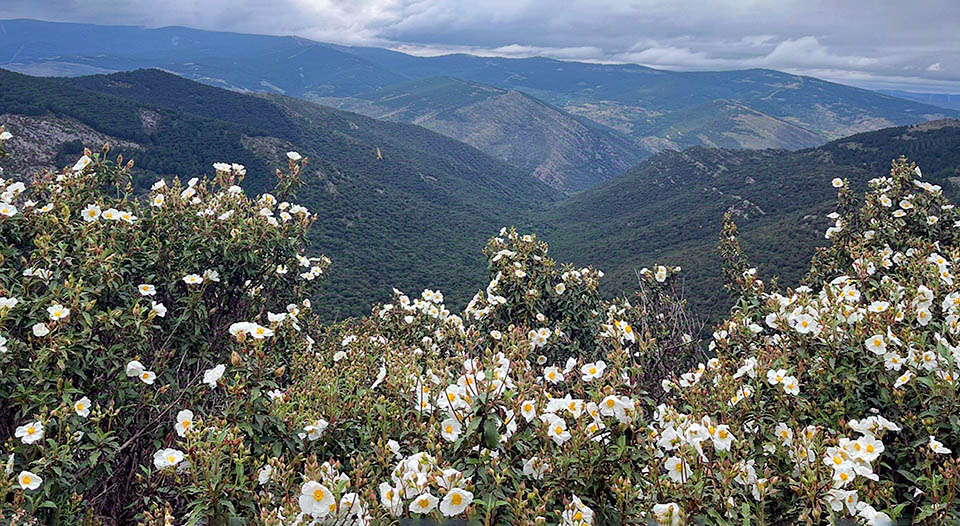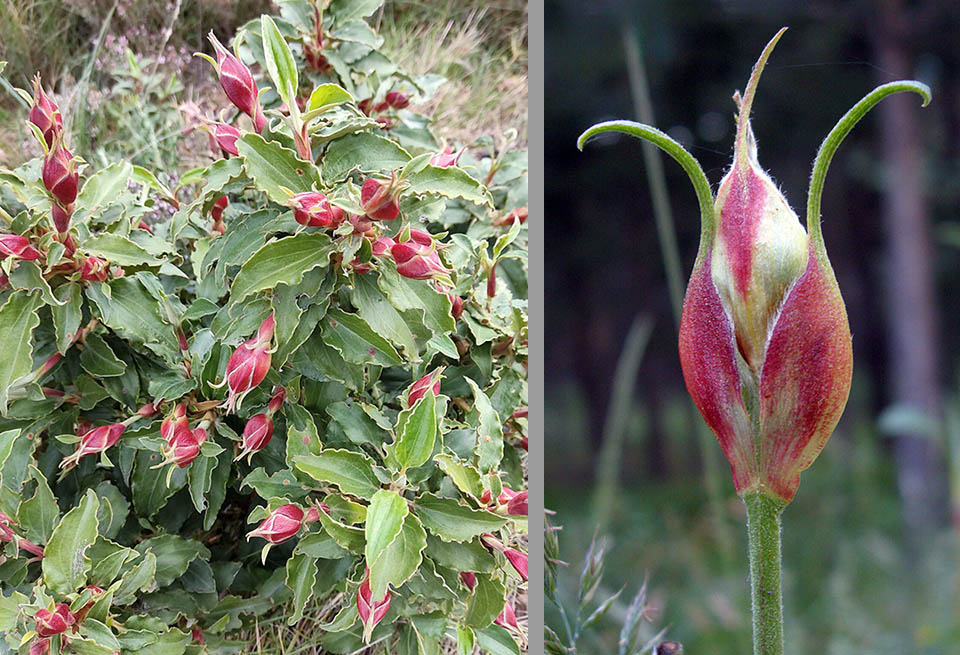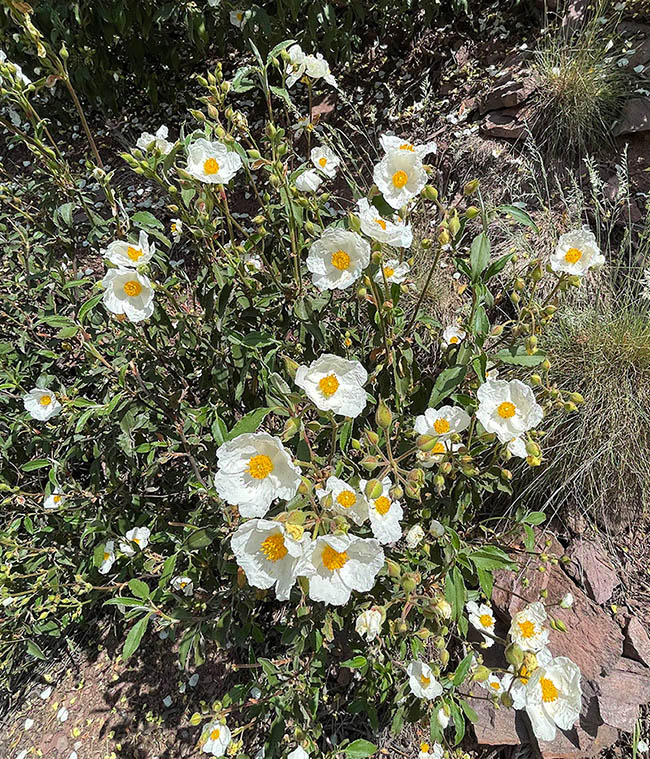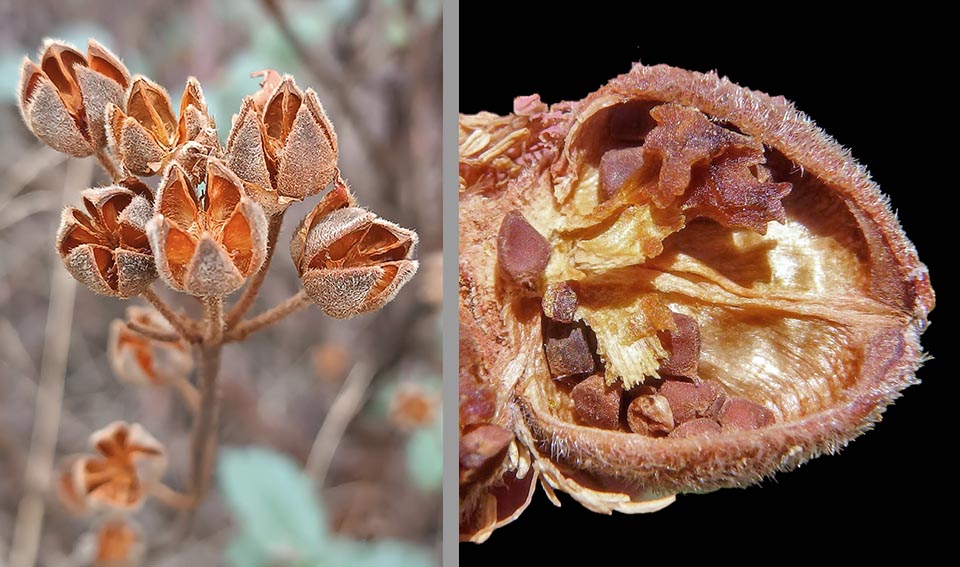Family : Cistaceae

Text © Prof. Paolo Grossoni

English translation by Mario Beltramini
Cistus laurifolius L. (1753) belongs to the genus Cistus L. (1753), family Cistaceae Juss. (1789). The nominal epithet ‘laurifolius’ points out that its leaves, due to their shape and colour, remind those of the laurel (Laurus nobilis L.).
In Italian it is commonly called ‘cisto laurino’, ‘cisto maggiore’, ‘cisto a foglie di lauro’, in French it’s ‘ciste à feuilles de laurier’, in English “laurel-leaved cistus”, “laurel-leaf cistus”, ‘laurel-leaved rock rose’, in Spanish ‘estepa de montaña’,
‘estepa negral’, ‘jara de montaña’, in German ‘Lorbeerblättrige Zistrose”, ‘Lorbeer-Zistrose’.
Evergreen shrub, it may reach a height of 150 (200) cm; the crown, dense and not very expanded, has the branches with orthotropic development, but, if shaded, it can get a procumbent appearance spreading out in a disorderly manner, in order to reach more illuminated zones.
The young branches are initially greyish, viscous with a thick pubescence also glandular; then the rhytodome becomes glabrous., gets a greenish red to brownish colour and then detaches in long stripes. The annual development of the twigs stops when the high summer temperatures arrive.

Cistus laurifolius range is divided in two sectors almost completely separate: the western (Morocco, Iberian Peninsula, southern France) and the eastern (Greece and European Turkey, Anatolian Peninsula and Black Sea Basin). Conversely, Greece excepted, it’s absent in the Balkan Peninsula and in the Mediterranean islands © Lesuridantar
The leaves are simple, opposite or decussate. They stand among the biggest of the genus as they may reach 8(9) cm in length and 30 mm in breadth; the petiole, that at the base sheathes the twig, is short (7-20 mm) and is finely pubescent. The lamina is ovate-lanceolate with entire and slightly wavy margin; the apical part gradually fades away ending in a more or less elongated apex. The upper pagina is glabrous, glossy and intense green whilst the lower, white in the younger leaves due to the dense tomentosity, becomes then pale grey; the primary veining is sided by other two, less evident, that run almost parallel. The leaves fall off about fifteen months after their germination.
The flowers, hermaphroditic and actinomorphic, are quite big (4-6 cm of diameter), decidedly ephemeral and merged in groups of 4-8, on more or less umbelliform cymose inflorescences and long pedunculated.
The corolla is formed by 5 candid petals having no yellow basal claw; the ovary, superior, is formed by 5-6 carpels; the pistil has a very short style (practically subnullo) and is surrounded by very numerous yellow stamens.

The simple leaves, opposite and decussate, among the largest of the genus, may attain 8-9 cm. Right, detail of flower in bud © Víctor Huete Pelaez (left) and © Franck Curk
The calyx is formed by 3 about ten millimetres long oval sepals, tuberculate, covered by a pubescence that later on decreases greatly. The flowering follows shortly after budding: it begins in May and lasts for almost all the following month starting again by the end of the summer aridity. The flowers are intensely visited by many insects.
The fruits ripen at the beginning of the autumn; they are about ten millimetres long loculicidal capsules, roundish or slightly ovate, subdivided in 5 chambers that when mature open along the lateral walls freeing several very small and light (0,8-0,9 mg) seeds that are dispersed by the wind, the rain or by the animals.
The chromosome number is 2n = 18. The root system is robust and may expand up to 3-4 m far penetrating more than one metre in depth. Especially during the first years of life, where the winter temperatures may continue for several days up to -12/-15 °C, it is good practice to mulch the roots. It is a heliophilous, thermophilous and xerophilous species.

The hermaphroditic and actinomorphic flowers are quite big, decidedly ephemeral and merged in 4-8 groups, on cymose inflorescences looking more or less umbelliform and long pedunculate © Dominique Hämmerli
It requires mild winters and warm and dry summers but as it can tolerate low temperatures it can be grown in open air even in the regions of central-western Europe with oceanic climate provided it is not exposed to the cold winds and to waterlogging.
The tolerance to the water stresses is based on the root system and on the capacity of the cells of the parenchymas to control the dehydration.
Therefore it prefers sunny or slightly shaded exposures with stony or sandy soils, consequently well drained, that are also oligotrophic and decalcified. In these environments it participates in more or less degraded shrublands, in garrigues and in pastures and in abandoned crops; it can also share the undergrowth of pine, olm oak and deciduous oak forests wherever direct light can reach. Especially in the zones where the wood vegetation has been cancelled by the fire and by the man, it may form even very vast populations.
The laurel-leaf cistus is a ‘pyrophyte’ that reacts very well to the passage of a fire reactivating the not damaged ‘dormant ‘ buds of the basal tuft as well as safeguarding the germination capacity of the embryos thanks to the hardness of the covering integuments and to the conformation of the embryo. The laurel-leaf cistus is a steno Mediterranean species.
Its range is divided into two sectors almost totally separate: western sector (Morocco, Iberian Peninsula, southern France) and eastern (Greece and European Turkey, Anatolian Peninsula and Black Sea Basin). Conversely, with the exception of Greece, it is absent in the Balkan Peninsula and in the Mediterranean islands.
Almost like a connecting ‘hinge’ between the two sectors, on the southern slopes of the Pratomagno (Tuscany), exists the unique Italian spontaneous station. This is the only one in the central area of the Mediterranean Basin since the other Italian populations, isolated from each other, have disappeared whilst the Corsica one has been found to be of artificial origin.
The laurel-leaf cistus is a melliferous plant and, even if the single flowers of the laurel-leaf cistus wither within the second day, the plant can continue to flower for about two months representing for many pollinators a continuous source of food. This is an advantage not only for the other plants (including the cultivated ones) visited by the entomofauna but also for the whole of the relevant food chain and, obviously, for the honey trade.

They may reach 6 cm of diameter. The stamens, like in all Cistus, are rich in pollen © Robert Combes
Besides the honey, sought after for its aroma and flavour, also the production of the resin, secreted by the glandular hairs and rich in oxygenated derivatives of some terpenes and flavonoids, has commercial interest because it is utilized in perfumery even if, being less effective than that of the gum rock-rose and of the pink rock-rose, is less requested. Some drugs derived from the laurel-leaf cistus have been found effective in various gastrointestinal pathologies. The most relevant use is however that in the ornamental nursery field. The success of this cistus is not due only to the elegance of the foliage and of the flower, to the delicate scent and to the duration of its blooming but also to its easy growing.
The only important attentions in the care of these plants concern the suitability of the site where to put the plants in place and the Autumnal and light pruning, to be done by eliminating only the branches of the last year. With this precaution the plant may live adequately at least fifteen years.
The species Cistus laurifolius is subdivided in two subspecies (WFO World Flora Online, 2025):

The fruits are about ten millimetres long loculicidal capsules, roundish or just ovate, subdivided in 5 chambers that when ripe open along the lateral walls freeing numerous very small and light seeds (0,8-0,9 mg). They are dispersed by the wind, the rain or by the animals © adriangasteiz ( left ) © Pedro Antonio Lázaro Molinero ( right )
subsp. laurifolius, present throughout the Eurasian sector of the range;
subsp. atlanticus (Pit.) Sennen & Mauricio (1933); endemism of Morocco, has smaller dimensions, smaller leaves and very elongated inflorescence peduncles.
Synonyms, now obsolete, are Cistus laurifolius var. atlanticus Pit. (1918), Cistus laurifolius var. lanceolatus Rouy & Foucaud (1895), Cistus laurifolius var. ovatus Rouy & Foucaud (1895),Cistus laurifolius var. prostratus Senner (1936) and Ladanium laurifolium Spach (1836).
Cistus laurifolius has originated numerous natural and artificial hybrids; the most employed in the ornamental green are originated with species of the clade PPC (‘Purple Pink Clade’), such as Cistus ×bornetianus Demoly, Cistus ×sammonsii Demoly, Cistus ×sammonsii Demoly as well as with species of the clade WWP (‘White or Withish Pink Clade’), quali Cistus ×oblongifolius Sweet, Cistus ×cyprius Lam., Cistus ×ledon Lam. e Cistus ×dubius Pourr. Finally, for multiple hybridizations do exist: Cistus ×argenteus Dans. Cistus ‘Jessamy Beauty’ e Cistus ‘Jessamy Charm’.
→ To appreciate the biodiversity within CISTACEAE family please click here.
